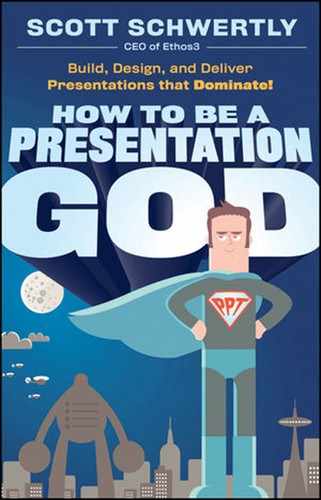Chapter 10. Parting the Clouds
Me? I like sitting at home on Saturdays trying to figure out how to make a PowerPoint 2007 file convert to a laptop that only has Keynote 2009. I think of it as technological skydiving, mainly because it makes the hair on the back of my neck stand up and because, if I am unsuccessful in my endeavor, every bone in my professional body will be pulverized into a fine powder. That sort of primal fear is fun to me; it's like playing Clue with a friend who actually is a killer.
Since I'm writing for a larger audience, though, I have to assume that at least a small percentage of you don't enjoy occupational Russian roulette, and might not get any sort of sadistic pleasure out of arriving at a presentation venue only to discover that the projector is not compatible with your computer and you'll have to use the archaic house system that lacks any sort of file management or conversion capability. The thing about "planning ahead" is that we usually learn to do it only once we've been burned, badly. That first time is always a doozy. When the inevitable happens, you hopefully have a flipchart and one of those fist-sized markers that lets you write in 60-point font. Otherwise, you may want to encourage all decision makers to huddle up at your feet.
PowerPoint has been the de facto presentation design software since it debuted in 1987. For many years, the primary advantage it had over potential competitors was that it merely existed. Keynote 1.0 debuted in 2003, just 16 years later. Other programs have come and gone, but these two enjoy the sort of rich market suffusion that only the most successful technology companies in the world can provide. Sure, there've been problems over the years: The templates are boring, the capabilities are not ambitious, the vintage years don't sync well, the display is sometimes indescribably awry, and the programs—especially PowerPoint—seem to occasionally crash just for fun. But both have been good to some people some of the time. And really, what more can we ask for?
Evidently, a lot: hordes of revolutionaries are taking their business, or at least their presentation design, to the grid. It will no doubt come as a surprise for many that other options actually do exist. This is sort of like trying to discover where you are going to Google something if not at Google. Remember: we're giving presentations here, not PowerPoints or Keynotes. Well, maybe we're giving keynotes, but just this once let's not fall victim to Steve Jobs' marketing savvy.
The truth is that PowerPoint and Keynote have existed in false competition with one another for decades simply because of their ubiquity, a quality that has more to do with their honorary positions in the Microsoft Office and Apple iWork suites of software (respectively) than with any sort of inherent virtues. Slide design and content organization should be simple to begin with, so we're really not looking for programs that have some sort of magical thought-converting algorithms that take harebrained ideas and turn them into multimillion-dollar patented inventions. No, what we really want is seamless convertibility and crisis avoidance technology. We're simply trying to show up at a venue without the cycle of fear touchy programming instills.

You might get the impression that I'm anti-PowerPoint and anti-Keynote. Far from it: In my capacity as CEO of presentation design company Ethos3, I utilize both programs on a daily basis. Quirks and frustrations aside, these programs do allow the habitual presenter to produce meaningful slide decks every day. They're standard on most computers, which sets my heart somewhat at ease, since it ensures that presentations are not being designed with the spray paint feature in Microsoft Paint—or worse, with bullet points in 60-point font on Word documents.
But competition is ultimately good for us—the little revolutionaries seeking to take over the planet with our world-changing Pez dispenser modifications and the hopes for distribution that go along with them, or whatever other crazy ideas we might have. New presentation design applications that have the potential to improve presentation design for the common man are cropping up—a development that should have serious ramifications in Pez after-markets around the world (not to mention the other industries and sectors that rely on presentations to get the job done).
The latest trend across all facets of technology seems to be cloud computing and web-based applications. This is closely linked to open source computing and networking. Everything we do these days depends heavily on the Internet, and the world of presentation design and management is no different. Some promising applications that will revolutionize the way you design your presentations—if you let them—have recently appeared. And the gripping fear you feel while waiting to see if your laptop will synchronize with the projector? That could change, too.
